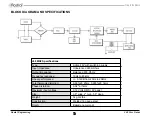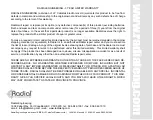
True to the Music
Radial Engineering
J48 User Guide
6
Getting to know your Radial J48
As a rule, all direct boxes follow the same basic procedures when connecting them to a sound system. The instrument plugs
into the IN, the musicians’ instrument amplifier connects to the THRU, while the mixer or recorder is connected from the
XLR ‘OUTPUT’. Since the XLR output connection to the mixer taps the signal
before
it goes to the musician’s amplifier, this
allows the mixing engineer to ‘capture’ the signal
before
it is modified by the musician, thus resulting in the purest source
possible.
It is important to note that what may sound good on stage may not necessarily sound good in the venue.
By sending an unaltered signal to the front of house mix position (FOH), the engineer is able to get the sound he is look-
ing for with minimal phase and harmonic distortion. This is likely the main reason why Radial direct boxes are so popular.
Radial DI’s do not alter the sound in any way before it gets to the mix position.
High to low impedance conversion and balancing
The Radial J48 features a 220kOhm input impedance for the instrument. As the signal passes through the J48 to the XLR
output, it is converted to a balanced 600-Ohm low impedance signal. This allows long cable runs without introducing noise
into the audio signal path. It is important to note that the output of the Radial J48 is mic level. This allows the J48 to be
used alongside microphone signals without introducing cross-talk or causing saturation when driving the signal through the
mic-bridging transformers of a splitter snake.
Phantom powering
The Radial J48 is an active direct box. This means that it employs a powered circuit to convert the impedance and balance
the signal. The J48 derives its power from the mixing console using remote phantom power. Phantom power is a clever
48V-DC supply that comes from the mixer and runs on top of the audio through the XLR mic cable without affecting the
audio. It was originally designed to provide power to capacitive or condenser microphones.
When direct boxes first appeared they used batteries. The problem with batteries is that when they run low, they cause the
circuit to distort. It’s pretty simple: less power – less headroom. Phantom power solved the problem by providing a remote
power source that could eliminate the battery. Eureka! Phantom power gave us a stable power supply and no batteries to
worry about.




































